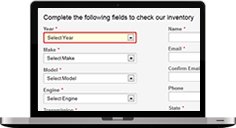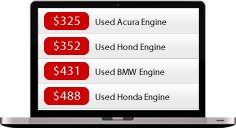A Dummys Guide to Understanding Your Car’s Used Engine
If you are looking for a used engines we can help! Fill out the form below to search our nationwide vendors of salvage yards for the best price and quick shipping.
Cars are such an important part of daily life, as they transport us almost anywhere we want to go. At the same time, however, most people are unaware of how these vehicles operate, taking their functionality for granted. The most important part of a car is its engine, and this guide is designed to help you understand better just how engines work.
Engine Glossary
Like anything else, understanding your car engine starts with an understanding of the different terms related to your engine. Here are twenty common terms you will see when you are reading about engines and the parts to which they refer.
1. Axle — The axle is the shaft connected to the wheels that, when turned by the engine, rotates the wheels and sends the car forward or backward.
2. Belts — Belts connect two pulleys together in your engine in order to transfer power. There are many different belts in every car.
3. Camshaft — The camshaft is a metal shaft located in the head of the cylinder that opens and closes the valves.
4. Cooling System — Comprised of the thermostat, radiator, radiator fans, water pump, and cooling hoses, the cooling system prevents your engine from overheating.
5. Crankshaft — Pistons act on the crankshaft to turn it, eventually turning the wheels of the car and propelling it forward.
6. Cylinder — Cylinders house the pistons and provide a place for the air-fuel mixture to be ignited.
7. Cylinder Head — On the top part of the engine sits the cylinder head, which houses the engine valves and, in most cases, the camshafts.
8. Dipstick — A dipstick is any of the long metal sticks used in an engine to check the levels of fluids such as transmission fluid and oil.
9. Drivetrain — This is the collective term for the primary engine and transmission parts that power the car and make it move.
10. Engine Block — This is the lower portion of the engine. It contains parts such as the pistons, crankshaft, and cylinders.
11. Fan — To keep your engine cooler and prevent overheating, the fan draws in air from the radiator and blows it over the engine.
12. Gearbox — Also known as the transmission, the gearbox is the portion of the engine that houses the gears.
13. Gear Grease — Gear grease is the grease that keeps the gears of your car lubricated.
14. Head Gasket — The head gasket is a mechanical seal that separates the cylinder head and the engine block. It prevents the mixing of coolant and fuel, which causes serious engine problems.
15. Motor Mounts — Motor mounts are the brackets that secure the engine to the car frame. They are covered in rubber.
16. Oil Pump — Lubricating oil is circulated through the moving parts of your car’s engine by the oil pump.
17. Oil Pan — Your car’s oil pan stores the oil from your car after it has been circulated through your engine.
18. Piston — The part of the engine that moves up and down in order to compress the mixture of air and fuel in the engine that will be ignited to power the car’s movement. Each cylinder contains one piston.
19. Supercharger — To increase power via stronger combustion, many engines have a supercharge that forces extra air into the cylinders of the engine.
20. Timing Belt — The camshaft is connected to the crankshaft with the timing belt, and makes sure that the valves open at the optimal time for fuel ignition. In some cars it is a belt and in others it is chain.
21. Valves — Valves allow the entrance and exit of fuels and gases into the cylinder for combustion and release. The intake or inlet valve lets the air-fuel mixture flow into the cylinder, and the exhaust valve allows the combustion exhaust to escape.
Engine Diagrams
You will understand your engine better if you know what it looks like. These resources provide some great internal engine diagrams.
• Sun Devil Auto Diagrams — Visit this page to view many different auto diagrams, including engine diagrams.
• Wiring Schematic — Do not let the wiring title fool you, as there are many engine schematics and diagrams on this page.
• Your Engine 101 — This page has a handy interactive car engine diagram that explores the different parts of an engine.
How Engines Work
Most car engines are variations of the internal combustion engine. Consult these resources for a better understanding of how most car engines work.
• 4-Stroke Internal Combustion Engine — NASA has put together this page on the basics of how the most common internal combustion engines work.
• Animated Engines — The first four engines on this page are commonly found in trucks, cars, and motorcycles.
• How Car Engines Work — This guide from howstuffworks.com is a full guide to car engines and their operations.
• Learning and Assessment: Auto Engines — Here is an extensive pdf guide on the operations of car engines.
• The Workings of a Car Explained — This is a rather thorough guide to how engines work.
Problems with Engines
If you know some of the most common problems that car engines face, you can work to prevent and even repair some of them. What are the most common car engine problems. Read these sources to find out:
• 5 Common Car Problems and What They Cost to Fix — Several engine problems are covered on this page along with how much they cost to fix.
• A Beginner’s Guide to Diagnosing Car Engine Problems — If you do not have much experience with care engine problems, this short guide can help you.
• Car Problems: Engine Problems — Here on this site you will find out how to diagnose engine problems and what to do about them.
• Diagnosis and Repair Help for Common Car Problems — If you have engine trouble, you will want to check out this page.
• Solving Car Engine Problems — Consult the guide on this page to consult and address common engine problems and difficulties.
Other Engine Links
There is much more that could be said about car engines and maintenance. These links will take you to further resources, games, tips, and much more related to car engines.
• Airplanes, Cars—What’s the Difference? — Plane & Pilot magazine offers the basics between planes, cars, and their engines.
• Car Engine Components Game — Play this game to help you learn different engine parts.
• Diesel Engines: The Basics — The U.S. Department of Energy is the source of this handy guide to diesel engines.
• Efficiency of an Internal Combustion Engine — Here you will read all about energy efficiency and the internal combustion engine.
• How to Build a 100-Mile-Per-Gallon Car Right Now — Learn the changes that are being made to engines and other components in order to build a car with incredible gas mileage.
• How to Build Your First Engine — Car Craft magazine offers this pictorial guide to building your very first car engine.
• How Rotary Engines Work — Here you can learn about how a different kind of engine, the rotary engine, works.
• How to Change Your Oil — This helpful site explains how to change your engine oil in the context of a discussion of how engines work.
• Internal Combustion Engines — This pdf on internal combustion engines is quite informative.
• Unconventional Ways to Improve Your Fuel Economy — Keep your engine clean, this article explains, in its look at an unconventional way to improve fuel economy.
Written by: Milan Alcot



